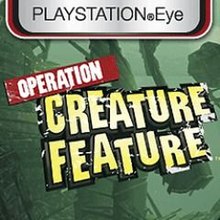
The PlayStation 3 (PS3) is a home video game console developed and marketed by Sony Computer Entertainment. The successor to the PlayStation 2, it is part of the PlayStation brand of consoles. It was first released on November 11, 2006, in Japan, November 17, 2006, in North America, and March 23, 2007, in Europe and Australia. The PlayStation 3 competed primarily against Microsoft's Xbox 360 and Nintendo's Wii as part of the seventh generation of video game consoles.

Uno, stylized as UNO, is a proprietary American shedding-type card game originally developed in 1971 by Merle Robbins in Reading, Ohio, a suburb of Cincinnati, that housed International Games Inc., a gaming company acquired by Mattel on January 23, 1992.

The EyeToy is a color webcam for use with the PlayStation 2. Supported games use computer vision and gesture recognition to process images taken by the EyeToy. This allows players to interact with the games using motion, color detection, and also sound, through its built-in microphone. It was released in 2003 and in total, it has 28 games.

Sega Superstars is a party video game developed by Sonic Team for the PlayStation 2. It was published by Sega and released in Europe on October 22, 2004; in North America in November 2, 2004; and in Japan in November 11, 2004. The game features several minigames based on various Sega titles that are controlled using the EyeToy peripheral. Upon release, the game received "average" review scores from critics.
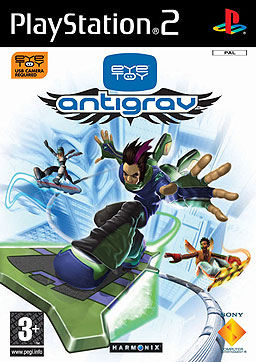
EyeToy: AntiGrav is a hoverboard game by Harmonix, released in November 2004 for the PlayStation 2. It was touted as the first "real" game for EyeToy targeted to more seasoned gamers. The earlier games such as Play and Groove were geared towards younger players for family or party fun. Unlike the earlier EyeToy games, the player's image is not shown inside the Antigrav game. Instead, the player's movement is reflected in the animated character in the game. The player moves their body to guide the on-screen character through a track. Some obstacles require the player to crouch or jump. Up to 4 players are supported. The game was released in the U.S. in November 2004, and in PAL in March 2005.
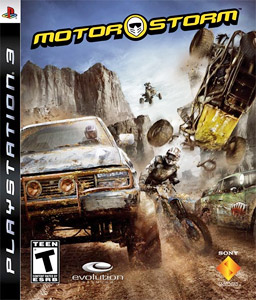
MotorStorm is a 2006 racing video game developed by Evolution Studios and published by Sony Computer Entertainment for the Sony PlayStation 3 computer entertainment system. Announced at E3 2005, the game was released in Japan on 14 December 2006 and worldwide in March 2007. MotorStorm has sold over 3 million copies. Two sequels were made, MotorStorm: Pacific Rift in 2008, and MotorStorm: Apocalypse in 2011. Another game was also created, MotorStorm: Arctic Edge, for the PlayStation 2 and PlayStation Portable. As of January 2012, the online multiplayer servers for the game have been permanently shut down.
A video game accessory is a distinct piece of hardware that is required to use a video game console, or one that enriches the video game's play experience. Essentially, video game accessories are everything except the console itself, such as controllers, memory, power adapters (AC), and audio/visual cables. Most video game consoles come with the accessories required to play games out of the box : one A/V cable, one AC cable, and a controller. Memory is usually the most required accessory outside of these, as game data cannot be saved to compact discs. The companies that manufacture video game consoles also make these accessories for replacement purposes as well as improving the overall experience. There is an entire industry of companies that create accessories for consoles as well, called third-party companies. The prices are often lower than those made by the maker of the console (first-party). This is usually achieved by avoiding licensing or using cheaper materials. For the mobile systems like the PlayStation Portable and Game Boy iterations, there are many accessories to make them more usable in mobile environments, such as mobile chargers, lighting to improve visibility, and cases to both protect and help organize the collection of system peripherals to. Newer accessories include many home-made things like mod chips to bypass manufacturing protection or homemade software.

Ape Escape is a series of video games developed primarily by Japan Studio and published by Sony Computer Entertainment, starting with Ape Escape for PlayStation in 1999. The series incorporates ape-related humour, unique gameplay, and a wide variety of pop culture references. The first game in the series is the first game to have made the DualShock or Dual Analog controller mandatory.

The Nintendo 64 controller is the standard game controller for the Nintendo 64 home video game console. It was first manufactured and released by Nintendo on June 23, 1996, in Japan; in September 29, 1996, in North America; and March 1, 1997, in Europe. It is the successor to the Super Nintendo controller and is designed in an "M" shape and features 10 buttons, a "Control Stick", and a D-pad.
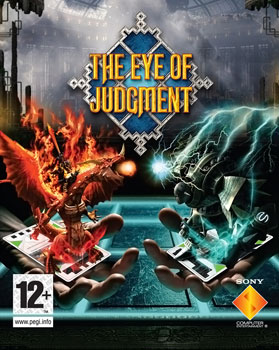
The Eye of Judgment is a turn-based card battle video game for the PlayStation 3 platform, which utilizes the PlayStation Eye camera peripheral. It is the first game to use the peripheral, with which it was available in a bundle in Japan, Europe, the Middle East, and North America. Once planned for release close to the PlayStation 3 launch in November 2006, the game was eventually released on October 25, 2007 as Set 1 in Japan.

The PlayStation Eye is a digital camera device, similar to a webcam, for the PlayStation 3. The technology uses computer vision and gesture recognition to process images taken by the camera. This allows players to interact with games using motion and color detection as well as sound through its built-in microphone array. It is the successor to the EyeToy for the PlayStation 2, which was released in 2003.

Snakeball is a downloadable PSN game on the PlayStation Store released 20 December 2007. It is a 3D variant of the "Snake" concept.
SingStar is a competitive music video game series for PlayStation consoles, developed by London Studio and published by Sony Computer Entertainment. Dozens of installments were released for the PlayStation 2, and several more for the PlayStation 3. It is also available on the PlayStation 4 as a free app download, with users paying for the songs as individual or bundle downloads. The games have also undergone a number of non-English releases in various European countries.
PlayStation is a video gaming brand that consists of five home video game consoles, two handhelds, a media center, and a smartphone, as well as an online service and multiple magazines. The brand is produced by Sony Interactive Entertainment, a division of Sony.

The Trials of Topoq is a puzzle video game developed by London Studio for the PlayStation 3 that utilizes the PlayStation Eye camera peripheral. It was released on the European PlayStation Store on October 25, 2007 and appeared on the North American PlayStation Store on December 20, 2007.
Poker tools are a variety of software or web-based applications that allow the statistical analysis of poker players, games or tournaments.
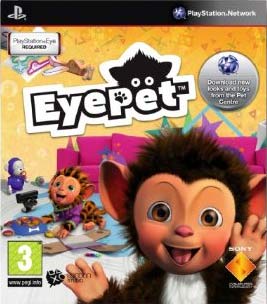
EyePet is a game for the PlayStation 3 and PlayStation Portable, developed by London Studio and Playlogic Game Factory. The original PlayStation 3 version was released in Europe on 23 October 2009 and in Australia on 27 October 2009. This version of EyePet was originally scheduled to be released in North America on 17 November 2009, but was held back. Instead, a newer version of EyePet adapted for the PlayStation Move motion control system was released in North America on 5 September 2010, where it is available in a bundle. In October 2010, the Move-adapted version was released in Japan and Europe, with the European edition entitled EyePet Move Edition. The game also supports 3D on 3D enabled TVs. The PSP version of EyePet was released on 2 November 2010.

Tori-Emaki is an interactive emakimono developed by London Studio in association with Playlogic Entertainment for the PlayStation 3 platform, which utilizes the PlayStation Eye camera peripheral. It was released on the European PlayStation Store on November 1, 2007 and on the North American PlayStation Store on January 17, 2008.
MotorStorm is a racing video game series developed by Evolution Studios, BigBig Studios, Virtuos and published by Sony Computer Entertainment. The titles were off-road racing games featuring different types of vehicles with their own strengths and weaknesses and tracks with different terrains which may either hinder the vehicles' handling or improve it.
